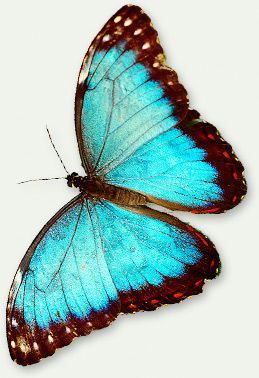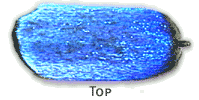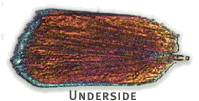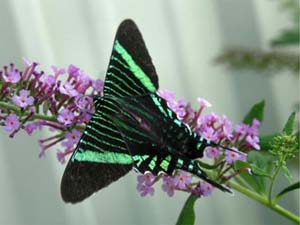A page from the "Causes of Color" exhibit...
Why are butterflies colored? (Interference)

Blue Morpho butterfly (Morpho menelaus). This brilliant blue butterfly can be found in the rain forests of South America (Brazil & Guyana).
Butterflies have fascinated humankind for millennia, and have been interpreted in a variety of ways, from omens of love to personifications of the soul. Yet, the delicate beauty of iridescent butterfly wings belies their intricate structure and functionality as the perfect foil for predators.
Structural colors are created by an optical effect (such as interference, refraction, or diffraction) rather than by a pigment. They arise from the arrangement of physical structures interacting with light to produce a particular color.
Structural color is responsible for the colors of the feathers of many birds (including the blue jay, hummingbirds and pheasants), as well as certain butterfly wings and beetle shells. Variations in the spacing of the pattern often gives rise to an iridescent effect, as seen in peacock feathers, soap bubbles, films of oil, and mother-of-pearl, because the reflected color depends upon the angle of view.
Butterflies and moths
The Morpho butterflies are among the largest in the world, with a wingspan of 7.5 to 20 cm. The males have beautiful metallic blue upper wings, while the females are drab. Their iridescence stems from the microscopic structure of their wings. Pilots flying over the rain forest can occasionally see brief flashes of blue as these butterflies travel above the forest canopy.
|
Blue Morpho butterfly (Morpho menelaus). This brilliant blue butterfly can be found in the rain forests of South America (Brazil & Guyana). |
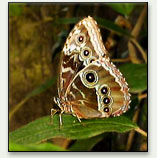
Underside of wings. When the Morpho lands, it closes its wings tightly, showing only the brown, camouflaged undersides, so a bird that is looking for a blue butterfly can’t see it. |
Iridescent surfaces, such as butterfly wings, help animals to elude potential predators. When these insects fly, the upper surface of their wings continually changes from bright blue to dull brown because the angle of the light striking the wing changes. As the butterflies move their wings up and down during flight, they seem to disappear, and then reappear a short distance away, looking like ethereal flashes of bright blue light. The dark undersides of their wings strengthen this effect. Combined with an undulating pattern of flight, this ability to change color quickly makes them difficult for predators to pursue.
What is iridescence?
The wings of butterflies and moths consist of a colorless translucent membrane covered by a layer of scales (the name of the order is Lepidoptera, meaning "scaly wings"). Each scale is a flattened outgrowth of a single cell and is about 100 µm long and 50 µm wide. The scales overlap like roof tiles and completely cover the membrane, appearing as dust to the naked eye.
The iridescence is caused by multiple slit interference. Sunlight contains a full range of light wavelengths. "Interference" occurs when light hitting the wing interacts with light reflected off the wing.
Light is a wave. If the crests and the troughs of the waves are aligned, or in phase, they will cause constructive interference, and iridescence is the result. One light wave hits the first groove, and a second light wave travels half of a wavelength to another groove, and is then reflected back in phase with the first.
If the crest of one wave meets the trough of another wave (out of phase), they will cancel each other out, as destructive interference occurs.
Why does the Morpho appear blue?
Blue light has a wavelength range from 400 to 480 nm. The slits in the scales of the Morpho are 200 nm apart. Because the distance between slits corresponds to half of the wavelength of blue light, this is the wavelength that undergoes constructive interference. The slits are attached to a base of melanin, a material that absorbs light, further strengthening the blue image.
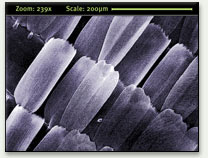
|
Top of wing (blue): |
Underside of wing (brown): |
Detailed views of scales from the wing tops, and wing undersides. Notice the veins in the magnified views.
Why are Morphos’ wing undersides brown?
The scales on the underside of the Morpho’s wing do not cause interference. This stems from normal organic pigments, rather than physical structure, and does not change with viewing angle. They resemble foliage, with lackluster browns, grays, blacks, and reds.
The iridescence is more useful on the topside of the butterfly wing, where it can be used to elude their main predators: birds. These scales also protect the wing from physical contact.
Each scale is about 70 by 200 µm, and is covered with thin parallel veins. The veins are much like ridges on a vinyl record. There are about 1,800 veins per millimeter. The texture forms a reflection grating. The veins are made of stacked chitin lamellae kept equidistant by fine braces. On the underside, the slits on the scales are 160 nm apart, less than half of any visible light wavelength, and thus do not cause visible interference.




